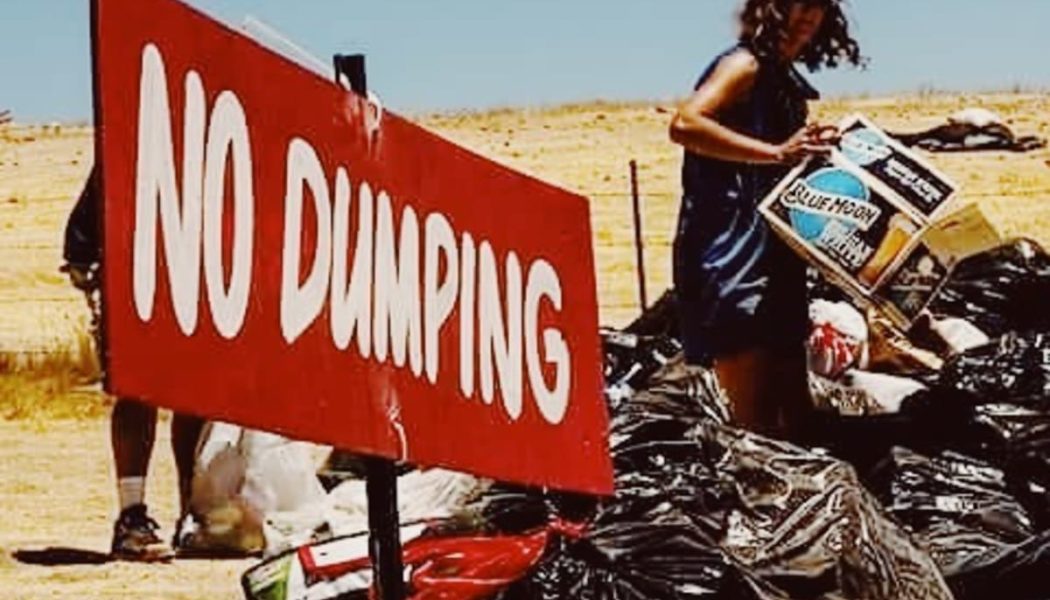Music festivals are some of the most magical, exciting, and glamorous spaces in the world.
For a few days, music fans can come together for an indelible experience. They can dance to their favorite music, make new friends, fall in love, and live their lives to the fullest.
But what happens when the festival ends? After festival-goers pack up their stuff, head out, and move on with their lives, people like Sophia Nielson are left to clean up the mess.
At just 26 years of age, Nielsen operates her own company, WEgenerative, with the aim to educate people about waste. She promotes sustainability at music festivals by designing and implementing waste infrastructure, contracting with events, managing volunteers who pick up trash (usually the largest crew on the festival grounds), and empowering underpaid waste workers.
Nielsen began volunteering at events at the age of 21, and pivoted into a professional capacity the same year. After volunteering and working with the trash crew at Burning Man, Envision, Desert Hearts, Lighting in a Bottle, and other major fests, she launched WEgenerative, LLC in 2020.
“One of the things that drew me into working in waste was having that experience of just feeling the weight of a trash bag. This volume, this amount of weight, I was really experiencing it in a more hyper aware way because I was picking up so much of it,” Nielsen told EDM.com. “At the end of a long day, I’ve worked 12 hours and I’ve tossed thousands of bags and I’ve felt the weight of all of these people’s decisions.”
“I have this relationship with this person where they don’t even know I exist,” she continued. “That was such a trip for me. I’m this invisible trash fairy that’s just compensating for someone else’s irresponsibility. Especially people that don’t even clean up their campsites. They didn’t even see it as trash, or see it as a problem.”
What Goes On Behind the Scenes
While much has changed due to COVID-19 safety concerns, the waste sorting process has always been intense work. Volunteers open as many garbage bags as possible and sift through them, handful by handful. Every piece of debris is picked up and placed into 20 or 30 streams, categorized by recycling, plastics, cigarettes, food, and who knows what else. The main goal is to divert as much as possible from the landfill.
On average, festivals create 50-100% more trash than the same amount of people would create in their everyday lives.
When it comes to waste, Nielsen prioritizes education. “The goal is to get the people who make the waste to sort as much of it as possible before it gets back-of-house,” she said.
To accomplish this, she aims to make the actual garbage bins as coherent as possible for passersby, with engaging signs and artistic setups. She’s even working on motion-activated sounds that will chime when the correct waste is placed in its corresponding bin.
On average, festivals create 50-100% more trash than the same amount of people would create in their everyday lives, depending on the event. This is mostly due to a lack of preparedness. For example, if a person doesn’t think to pack a reusable bottle, they will instead go through a large amount of plastic water bottles. Similarly, many people overpack their food, which ends up spoiling and left to rot in the sun—a phenomenon Nielsen calls “the cooler of dreams.”
“That cooler full of somebody’s dream brunch,” she said. “They thought, ‘Oh Sunday morning we’re gonna see this set and we’re gonna have a bacon egg breakfast with Bloody Marys!’ They just have this elaborate thing that in reality you’re never going to use because you’re going to be hungover and just eat a granola bar.”
It’s why Nielsen places a huge emphasis on topics like realistic preparation. “I love writing contracts and really investigating the nuts and bolts of what kind of commitments we’re making to each other as a community,” she explained. “The only way waste and sustainability can legitimately be in that framework—and isn’t just greenwashed words to throw around—is if it’s in the contracts.”
Nielsen has seen her fair share of atrocities during her time working with waste. When invited to speak about the most absurd things she’s seen at festivals, she explained that “the craziest thing is always the poop.”
Apparently some people cannot be bothered to use the portable toilets—and it’s more common than you’d think. “I think it’s hilarious because it’s these decisions people make where they think, ‘No one will ever know, this is between me and God!’ Nah, I found that. We see it all.”
Making Art Out of Trash
If anyone can get people to care about trash, it’s Nielsen. Since her childhood she’s been an artist, and she’s always cared about the environment. In fact, her first source of income was generated by collecting cans and recycling them for $0.10 per bottle. When she began studying art in college, she became fascinated with the idea of getting people to look at trash.
Our rubbish doesn’t magically disappear when we toss it into our bins, Nielsen says. “We’ve got society reinforcing this whole ideology where like, ‘It goes away!'” she points out. “It’s really important to me that people look at the trash. They’re not just tossing it away, they’re having an experience with it that’s memorable.”
For her college thesis Nielsen became inspired to create an immersive art project called “There Is No Away,” which was ultimately featured at the Silverado, CA music festival Boogaloo. From the outside, it looked like just a dumpster. But when people entered its belly, they were immersed in beautiful trash art.
“I made a ceiling canopy of trash above people so they could feel the weight on top of them,” Nielsen said. “And then underneath their feet was a rug that I wove out of the two most prominent sources of litter at the time, cigarette butts and plastic bags.”
At the house and techno music festival Desert Hearts, Nielsen joined the event’s fashion show lineup with her own line of “trashion.” She dressed models in clothing woven out of each specific trash stream, including landfill, recycling, compost, and cigarette butts. “I had all of our volunteers help design different outfits based on the streams that we had,” she said.
Nielsen’s Mission
The United Nations’ sustainable development goals for 2030 are centered around empowering oppressed populations. Nielsen harbors a similar overarching goal when it comes to sustainability.
“If an event calls themselves ‘sustainable’ or ‘green’ yet that only happens because the people who are working are underpaid, understaffed, and hurting at the end of it, that’s not sustainable,” she explained. “There are events that I won’t name specifically who are in it for the appearance of sustainability—but they don’t actually care about the waste workers.”
Much of the sorting at events is done by volunteers, who are doing the difficult dirty work that no one else wants to do. They are typically the largest volunteer group at the event and the last people onsite, because there’s so much waste.
“I don’t want to be invisible, it’s not okay with me,” Nielsen continued. “I’m not willing to clean up after somebody and not get a thank you for it. You’re gonna take me seriously, and you’re gonna take trash seriously.”











